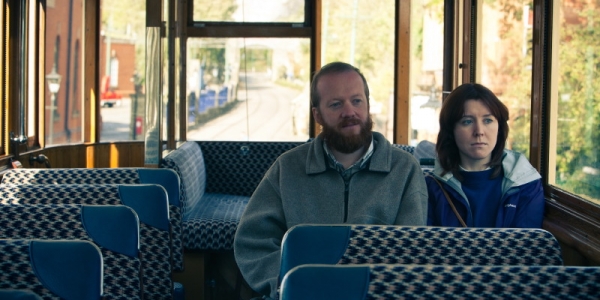Of the film’s vacillation between the comic and the morbid, Wheatley says, “It’s to bring you in and out of the comedy – so that you would feel it was serious, that it wasn’t all just a knockabout joke, and that murdering people’s bad”. Though he laughs to himself at the sheer obviousness of this last statement, the moral purpose of the film’s brutality comes across forcefully; showing the gory details keeps us at an appropriate distance from our anti-heroes’ actions, even as we’re made to share their revulsion at their victims.
Both Wheatley’s debut feature Down Terrace and last year’s singular Brit-crime/occult-horror mash-up Kill List ruthlessly shift gears and play with audience expectations and genre conventions; accordingly, his attachment to Sightseers in the pre-production stage came from the desire for a change of pace. “Kill List was in pre-production at that point, and I knew that it’d be really heavy and dark, so I wanted to line something up next which was going to be lighter and funnier”. Of course, these things are relative. “The apple doesn’t fall far from the tree,” the director admits. “To me, [Sightseers] is funnier, and lighter – to people who haven’t seen [Kill List or Down Terrace], it’s dark as pitch.”
Across his three low-budget features, Wheatley’s voice as a director is evident, in their unusual editing rhythms, contrapuntal soundtrack choices, and most prominently, the running theme of the banality of evil. However, he shows slight discomfort at the idea of being an auteur. “Once you get into those kinds of patterns, it’s slightly dangerous, and [so] you’ve always got your eye out – you try not to do things again and again… those kinds of motifs and things are a bit of a weakness more than anything.”
This could explain why Sightseers is the first of Wheatley’s features that he hasn’t written himself. The screenplay, written by actor-comedians Alice Lowe and Steve Oram, was forwarded to him by director Edgar Wright (Shaun Of The Dead, Hot Fuzz), who ultimately co-produced Sightseers. Oram and Lowe, who play the film’s deadly couple, debuted the characters on stage, followed by a short ‘TV taster’ – and their input perhaps accounts for the utter authenticity and believability of the main characters and their interactions, however absurd and shocking their actions become.
Of the film’s tonal shifts from humdrum naturalism to Grand Guignol gore set-pieces, Wheatley says, “You find that kind of stuff in [Monty] Python and in Terry Gilliam’s work, and in Paul Verhoeven’s stuff as well. I like that gear-changing, so that you question what you’re looking at, and you don’t just accept it as it is… it’s not safe, it makes the hairs on the back of your head go up and you have to think about what you’re consuming, instead of just sitting there being passive about it; that’s more interesting to me.”
Though Sightseers has a loose, spontaneous quality to its overall tone and surface texture, the impetus behind Wheatley’s inspired soundtrack choices – from the bookending versions of Tainted Love and the ‘70s Krautrock of Neu – reveal the film’s careful conception. “I always approach the films I’ve done with a strategy for the music, otherwise you get that thing where you end up with a shot of a car, and then you do some music research and get songs with cars in the lyrics,” says Wheatley. “I’d watched a documentary about [German progressive rock] a few years before [I made Sightseers]. I’d always assumed – or I’d kinda been told – that the UK had invented new wave and punk and all these things, and then as you start to look into music history you find out that it was the Germans that invented quite a lot of it, and it’s trendy producers in the UK using those albums as the template to make the music that came after. I really liked that idea; that the history, the cultural history, had a secret history that lay underneath it, and if you dig a little bit, you find it. I thought that’s what the characters are like, you think they’re one thing and you find they’re another thing.”
A neat correlation, but one that Wheatley acknowledges is only important insofar as the audience feels it before registering the connection on an intellectual level. “It doesn’t matter if the audience aren’t understanding that… as long as it’s been thought about, they’ll feel that there’s structures within the film, and I think that’s important, even if they’re invisible. You look at The Shining, and you can see that within that movie – there’s a lot in that film you don’t understand but it doesn’t matter, because someone thought about it.”
Sightseers played to great acclaim at this year’s Cannes Film Festival, where it won the prize bestowed upon The Artist last year – the Palm Dog, awarded to the best performance given by a canine. Wheatley warns, however, that the cute canine is part and parcel of Sightseers’ deceptive tendencies: “He’s one of the most cynical and evil characters in the film.”
BY IAN BARR

